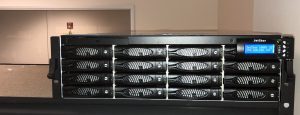Although RAID arrays can solve many storage problems, including speed and capacity limitations, it can be trickier or sometimes even impossible to recover data from a failed disk or multiple failed disks, and some RAID layouts contribute to that. Knowing this may impact which RAID level you choose, but failure is always a possibility. If you know when and how disaster can unfold, it can help prevent disk failure and improve your RAID data recovery chances.
These causes of data loss and RAID failure are often connected, with one event leading to the next.
Controller Malfunction
Controller malfunctions are among the most common types of data loss and are often caused by a power surge, which is why it’s so important to choose the right surge protection options.
Missing Partition
You may employ partitioning to reduce speed loss on your RAID. However, RAID failure can occur when the system cannot find a partition it expects. This may happen if you’ve recently modified partitions or if RAID striping has failed and corrupted the partition, causing drive failure. Furthermore, if the system cannot find a partition even though it exists, RAID failure or data loss can result.
Power Surge
Much like a power surge can damage a personal computer, it can also hard drive in a RAID array, leading to data loss. In fact, a power surge could also cause the controller to malfunction.
Data Deletion
While you probably don’t intend to delete necessary data, it sometimes occurs. Commonly, a reformat can delete data without you intended to do so. We’ve all heard the adage that it’s better to be safe than sorry, so backup data before you reformat any machines.
Malware
Whether due to a virus or another type of malware, RAID failure isn’t fun. Protect your hardware and data by employing robust antivirus software and firewalls. Use redundant backups so that ransomware doesn’t cause you to lose valuable data.
Multiple Disk Failure
If multiple hard drive disks fail simultaneously, you can pretty much count on a total RAID failure. Software configuration, hardware incompatibility, and power surge can all lead multiple drives to fail.
Wrong Replacement Drive
Choosing the wrong replacement for your RAID array can have disastrous results. Similarly, using a drive that is improperly formatted in your setup may have negative consequences that you’d prefer to avoid. Even if your replacement should be compatible, rebuild errors could cause drive failure and data loss.
Application Upgrade
Upgrading software can occasionally lead to data loss, especially if upgrading the application revokes access to the RAID disk for whatever reason.
System Setting or Registry Error
The fact that you can experience RAID failure due to a system setting or registry error shows how important software can be to hardware function. Make sure to double-check any settings before confirming them. You’ll want to avoid accidentally re-configuring your setup, which can happen when upgrading software.
How to Prevent RAID Data Loss
If you understand the types of RAID failures that can happen, you probably also understand the times when those failures are more likely. For example, you might experience a failure after installing new hardware or making software configuration change, so you can double-check hardware compatibility and software changes before making any adjustments. Failures due to power surges can happen after a storm or other electrical event. This risk can be minimized by using a datacenter that has enterprise-level battery and generator backup.. And because no drive lasts forever, it may be more common for them to fail after years of continuous operation or during times of particularly heavy stress or high temperature.
Because you cannot know exactly when RAID failure will happen, you should make backups. Redundant backups offer even more protection, whether you use on-site physical storage, the cloud, or both. You might also consider replacing older drives before they fail if you can afford it. You may prefer to purchase and install a new disk to minimize the risk of lost data and productivity, which can be more costly than buying a drive itself.
Can You Recover Data From a Failed Raid Disk?
Still, there are times when you may need to recover your data from a RAID or individual drive. You might be tempted to recover data yourself, which may be possible in some instances. There is software specifically for RAID recovery, some of which are free, that create images of the disk for you to work with. However, the recovery process differs depending on the RAID layout that has failed, and without experience there is a huge learning curve.
- RAID 0 failure can occur when either one or several disks have failed or when there is a failure not related to disks. This layout is non-redundant and has no fault tolerance, so you cannot recover data from a failed disk. Raid DATA recovery may be possible from the other drives.
- RAID 5 failure happens when one or several hard disks fail or because of operator or controller failures. Because RAID 5 is redundant, you can recover data from a single failed disk but not multiple failed disks. It may be possible to access data from the remaining disks, however.
- RAID 1E failures may allow you to replace a disk and rebuild the array or even replace multiple disks as long as the failed disks were not adjacent, but this array layout is less common.
Doing it yourself may risk complete data loss, especially if you’re new to RAID data recovery layouts, ultimately making the problem worse. You might also prefer to remove corrupted drives and have someone else focus on server data recovery while you focus on rebuilding your RAID and getting your system up and running once more. In these cases, outsourcing your data recovery needs is often the best option.
Get Help With Server Data Recovery
Whether you need to recover data on a single drive or your RAID array, services offered by DataRecovery.com can help. Contact us today for more information.




